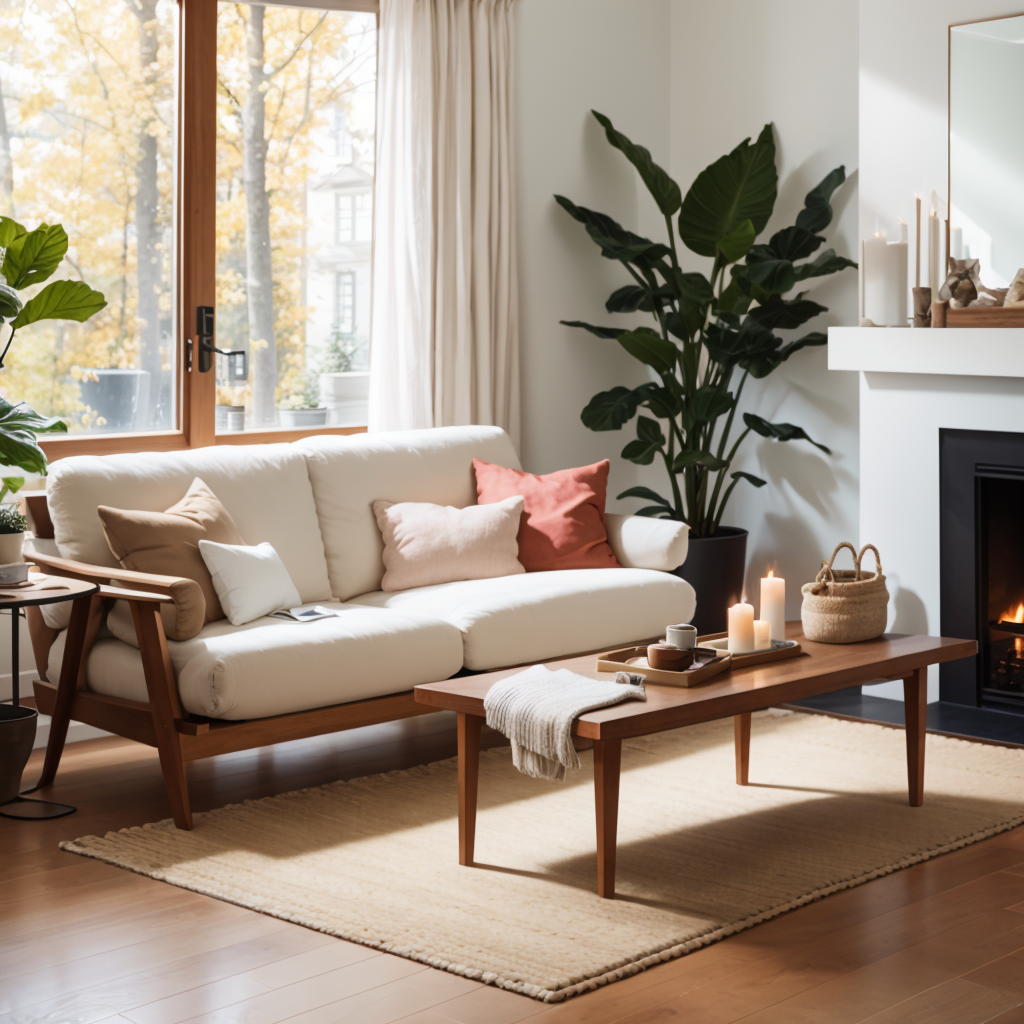
Scandinavian Interior Design Styles: Your Ultimate Guide
Table of Contents

What is Scandinavian Interior Design.
Scandinavian Interior Design is a minimalist design style characterized by simplicity, functionality, and a focus on creating bright and airy spaces with natural light. The colour palette typically consists of neutral tones such as white, beige, gray or black, while pops of colour may be added through accessories or artwork. Materials commonly used include wood, leather, and other natural materials that emphasize texture and tactility. Furniture designs are often clean-lined, with an emphasis on functionality rather than decoration. Overall, there is a sense of warmth created through the use of textures rather than colours or patterns in Scandinavian interior design.
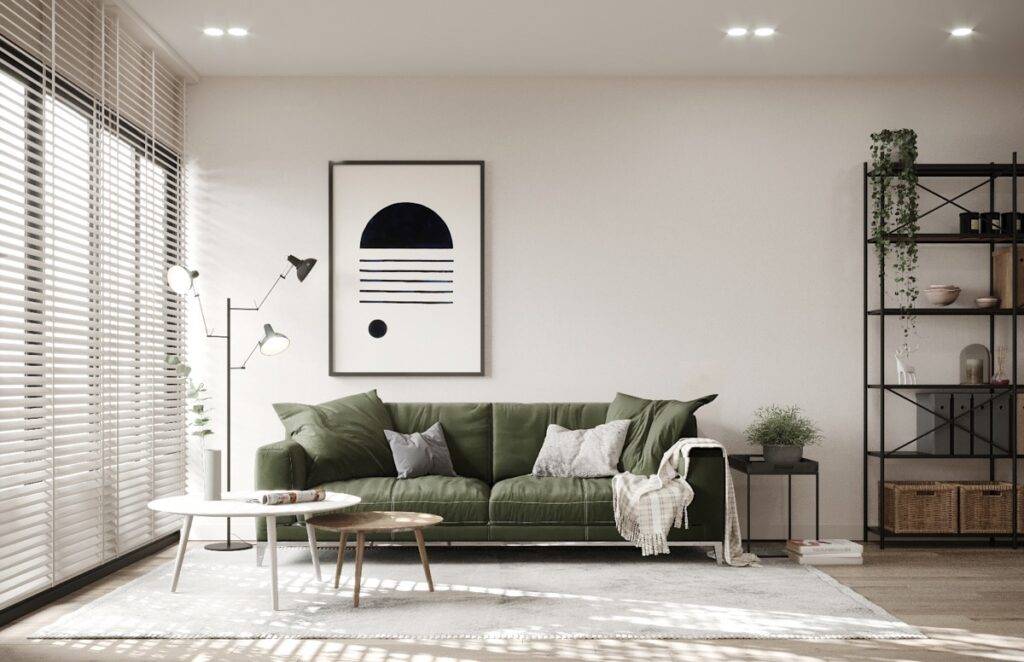
Scandinavian interior design is known for its minimalistic and functional approach to living spaces, as well as its use of light colours, natural materials, and clean lines. This style is rooted in the cultural heritage of the Nordic countries, but it wasn’t until the mid-20th century that it emerged as a distinct movement.
After World War II, Scandinavian designers began to adopt a more democratic approach to design that emphasized accessibility and affordability. The Nordic countries also experienced an economic boom during this time, which led to an increased interest in home furnishings and a desire for modern living spaces.
Designers such as Alvar Aalto from Finland and Arne Jacobsen from Denmark played significant roles in shaping the Scandinavian design movement. Their work emphasized simplicity and functionality over ornate decoration.
Today, Scandinavian interior design remains popular around the world for its timeless elegance and practicality. Its emphasis on sustainable materials also aligns with contemporary concerns about environmental responsibility.
Principles.
Functionality: A key principle of Scandinavian interior design is functionality. This means that furnishings and decor should be practical and serve a purpose rather than just being decorative. In other words, form follows function in Scandinavian style homes.
For example, a coffee table might include built-in storage or shelves to hold books or magazines, making it not only functional but also space-saving. Similarly, chairs and sofas should be comfortable for sitting but also complement the overall aesthetic of the room.
Simplicity: Another important principle is simplicity. This includes simple forms, clean lines and uncluttered spaces with minimal ornamentation – often referred to as “less is more”.
Scandinavian interiors are known for their uncluttered look, where every object has its place without overwhelming the space with too many unwanted items.
Light colours: Light colours like white and pastels are commonly used in Scandinavian interior design – this helps maximize natural light while creating an airy feel, which contributes to creating visually larger spaces.
These bright tones can create a calming atmosphere that facilitates relaxation while providing an inviting environment suitable for family & entertaining guests.
Natural materials: Scandinavians appreciate natural materials like wood because they reflect their connection with nature & environmental consciousness – which have been central values throughout history.
Wooden furniture pieces add warmth & comfort while providing durability & functionality that can stand up against harsh weather conditions – characteristic of Nordic countries.
Other natural materials such as linen or wool may also feature prominently within Scandinavian interiors designed for specific seasons like winter, where textures add warmth whilst complementing whites/pastel colour palettes.
Texture: Textured elements such as soft furnishings (patterns on rugs/throws/some cushions), wall art or plants can help bring depth into minimalist spaces by adding layers and visual interest within otherwise low-key environments. Textures create contrast that helps in breaking monotony and adding variety to the space.
Warmth: Scandinavian interiors can often feel colorless or cold, so creating warmth is essential. This can be achieved by adding soft furnishings like throws or area rugs. Adding lighting sources like candles, table lamps or string lights can also help create a cozy atmosphere to the otherwise minimalist spaces.
Connection with nature: Nature is at the core of Scandinavian identity, & it’s reflected in their architecture & interior design. Plants bring nature indoors while providing health benefits such as improved air quality and provide an element of biophilic design which aids relaxation and reduces stress levels.
In conclusion, these principles of simplicity, functionality, light colours, natural materials, texture, and connection with nature make up the foundation of Scandinavian interior design style creating modern yet timeless homes with functional designs that are assured to last for generations.
Colour Palette.

- White: One of the most prominent colours used in Scandinavian design is white. This light and bright colour reflects natural light and helps create an airy feel that’s typical of this style.
- Gray: Gray is another popular neutral used in Scandinavian interior design – it adds visual interest without being overwhelming and can be used on walls, furniture or soft furnishings such as cushions or throws.
- Beige & Pastel shades: Along with white & grey, pastels have become increasingly popular in recent years, with shades like pale pink, baby blue and mint green being popular choices for painting walls or adding soft furnishings that create a subtle contrast while complementing other elements within Scandinavian Interiors.
- Black accents: Black accents such as metal fixtures or dark furniture pieces are often incorporated into Scandinavian interiors to provide contrast against lighter tones & add depth to the space at a low cost.
- Natural shades like Brown/Tan: While not strictly a colour palette itself; natural wood finishes bring warmth to any space, which creates visual contrast whilst complementing other muted tones utilized within Scandinavian interiors.
- Green: Plants are considered an essential part of Scandinavian interiors bringing nature indoors while providing health benefits from improved air quality, thus offering an element of freshness for otherwise monotonous spaces.
In general, Scandinavians tend to use a limited palette with muted colours, allowing simple forms & functionality of furniture pieces to become central focus points within homes designed using this aesthetic approach.
It’s worth noting however that there is no strict rule governing the colours one should use for creating Scandinavian interiors; homeowners may choose whichever combinations suit their tastes but should ensure they remain true to minimalist ideals by not overloading spaces with too many contrasting hues!
Furnitures & Decors.
- Sleek, simple furniture: The key to Scandinavian design is simplicity, so choose streamlined furniture with clean lines and minimal ornamentation.
- Natural materials: Scandinavians love natural materials like wood and leather. Look for furniture made from these materials or add them in the form of decor items like throws, rugs or cushions.
- Light fixtures: Pendant lamps in simple shapes are a popular choice as they create pools of light that add warmth & ambience while providing task lighting where necessary.
- Neutral textiles: Fabrics should be woven from natural fibres such as cotton or linen in soft neutral shades including off-whites & muted blue/greys; patterned textiles are used sparingly if at all.
- Wall Art: Black and white prints featuring nature or abstract designs work well within Scandinavian Interiors adding depth to walls without overloading spaces with too much contrast.
- Plants: Potted plants can help bring life into any space reflecting the importance placed by Scandinavian design on natural living which is thought to improve mental wellbeing.
- Minimalist Shelving/Storage solutions: Open shelving units with clean lines offer practicality whilst allowing homeowners an opportunity to showcase favourite items.
- Fireplaces: Traditional fireplaces provide warmth, but also serve as focal points within many homes designed using this aesthetic approach.
Remember that less is more when it comes to Scandinavian interiors – you want your pieces of decor & furnishings to remain functional whilst also complementing each other rather than competing for attention; ultimately creating an environment conducive for relaxation after long working hours!
Materials & Finishes.
- Wood: Wooden floors, beams and furniture are essential elements of Scandinavian interiors as they create warmth in an otherwise minimalist space. Light-colored woods such as pine, ash or beech are commonly used, but you can also experiment with darker finishes like walnut.
- Metal accents: Metal accents in light shades like silver or gold add a touch of elegance to the interior without being too flashy.
- Concrete: Concrete is used quite frequently in modern Scandinavia as it provides texture & visual contrast against natural wood tones whilst remaining practical.
- Textured fabrics: Soft textured fabrics such as woollen throw blankets or cushions add warmth to space without detracting from the minimalistic aesthetic that’s synonymous with Scandinavia interiors; use of these pieces complementing other subtle hues found throughout spaces designed using this style.
- Leather: Full grain leather chairs or sofa sets work great within Scandinavian Interiors, offering a touch of luxury through their durability and longevity.
- Natural stone: Granite and marble countertops are popular choices for kitchens while slate tiles provide practicality for flooring solutions within bathrooms, catering to both warmth & functionality desired by homeowners opting for this aesthetic approach.
- Glass surfaces: Glass top coffee tables or dining tables support the lightness aspect synonymous with Scandinavian design without taking away from other key features found throughout homes decorated using this aesthetic approach.
Room-by-Room design guide.
Certainly! Here’s a room-by-room design guide for creating a Scandinavian interior design:
Living Room:
Scandinavian design is all about creating a space that’s minimalist yet functional. The focus is on clean lines and simple forms, with a careful balance between form and function.
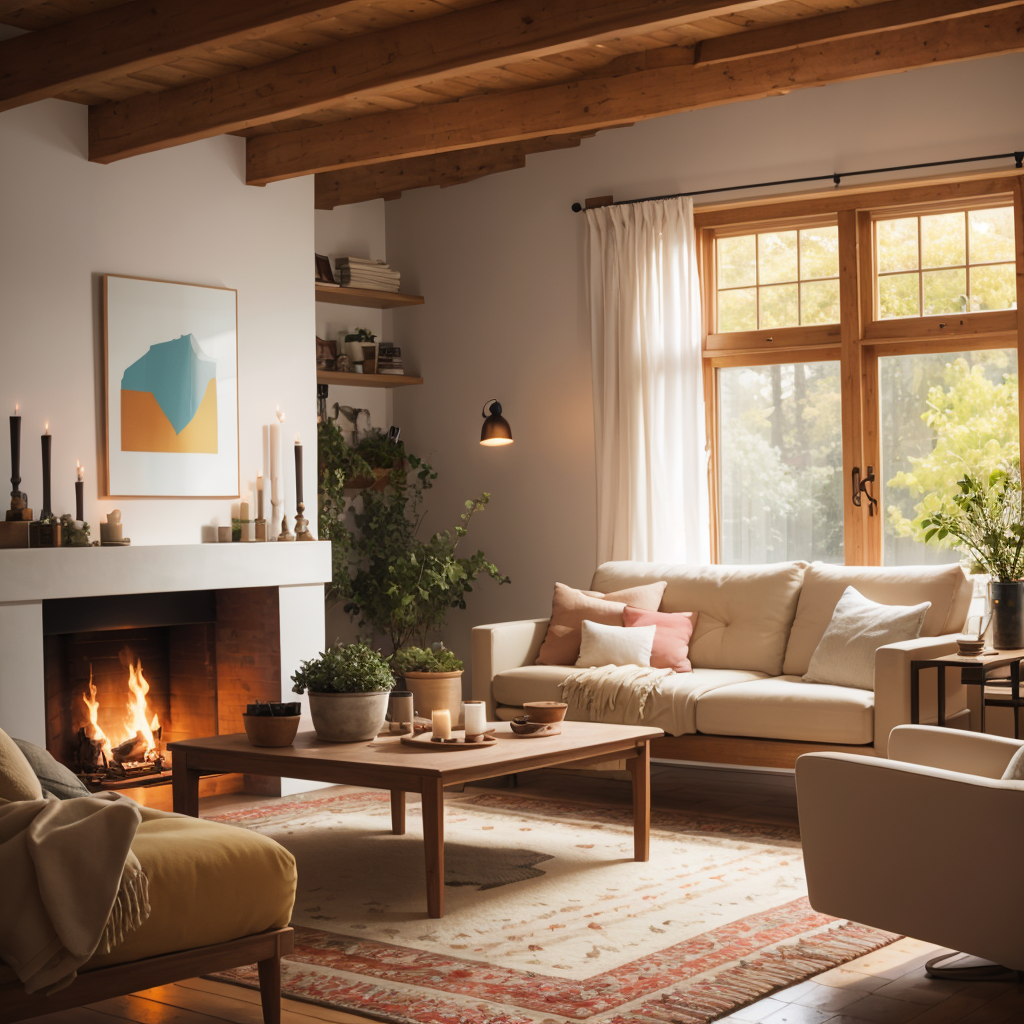
When designing the living room in Scandinavian style, I would recommend starting with the color palette. Neutral shades like white or light grey are a great backdrop for furniture and decor pieces to stand out. This also creates an airy atmosphere that emphasizes natural lighting.
In terms of furniture selection, it’s important to choose pieces that are both functional and stylish. Sofas should have sleek lines while still being comfortable enough for everyday use. Floating shelves are perfect for storage without taking up too much floor space whilst textured rugs help add depth & warmth to wooden floors.
Lighting is another important element in Scandinavian interior design – natural light from windows or skylights should be maximized at all times! Artificial lighting can be kept simple yet impactful using statement pendant lights alongside understated floor lamps providing optimal functionality within your space.
When it comes to accessories such as artwork or decorative items on floating shelves; choose pieces reflecting nature-inspired themes which create visual interest without over-cluttering; creating an overall cohesive feel throughout your living area inviting you inside after long days at work!
Kitchen:
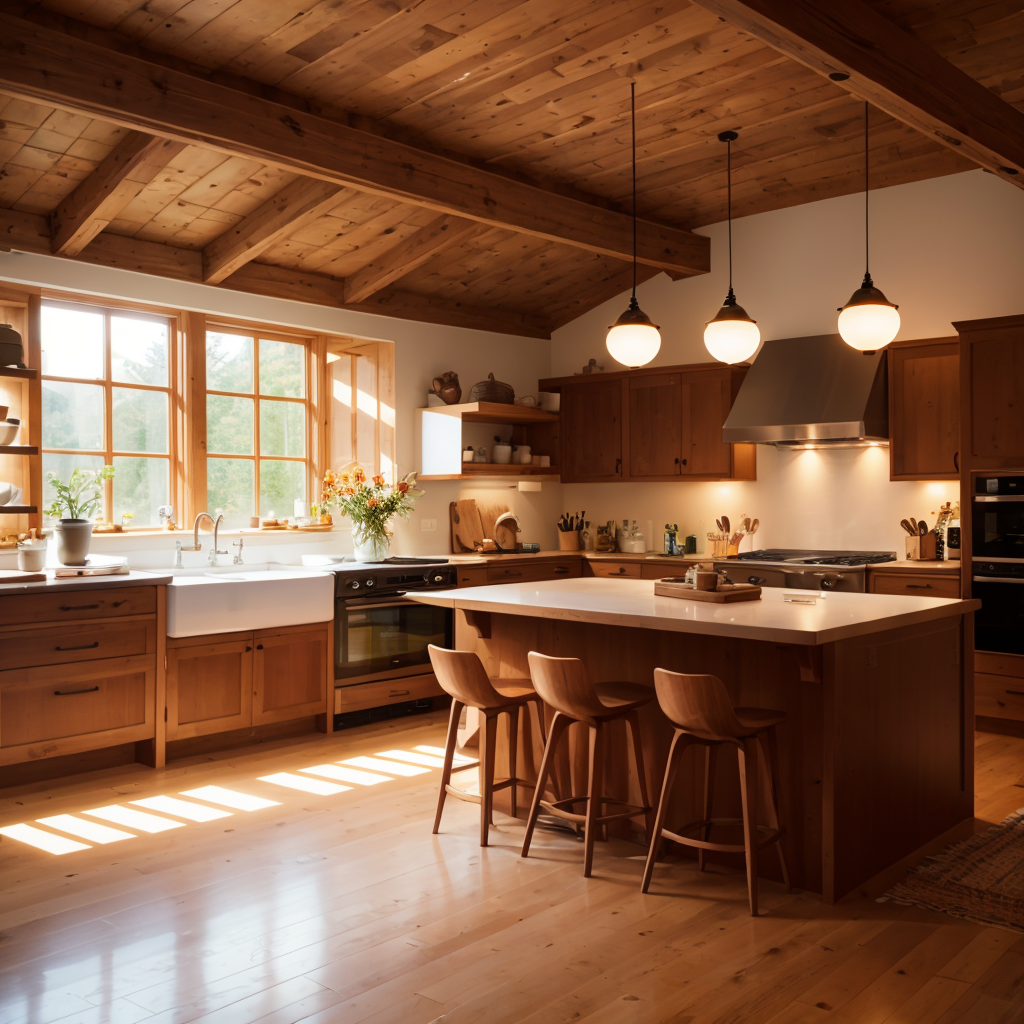
When designing a kitchen in the Scandinavian style, here are some key features to consider:
- Light Colours: Use light colours for walls and cabinets to create a light and airy feeling. White or off-white shades are commonly used with wood or other natural materials.
- Natural Materials: Incorporate natural materials like wood, stone or concrete into your design. For example, you could use wooden flooring along with wooden cabinets and countertops.
- Functional Layout: The kitchen should have an open layout that allows for ease of movement while cooking or entertaining guests.
- Minimalistic Design: Keep the design simple without any unnecessary decorations or cluttered surfaces.
- Lighting: The lighting should be warm but bright enough to provide ample visibility around the kitchen area.
Bedroom:
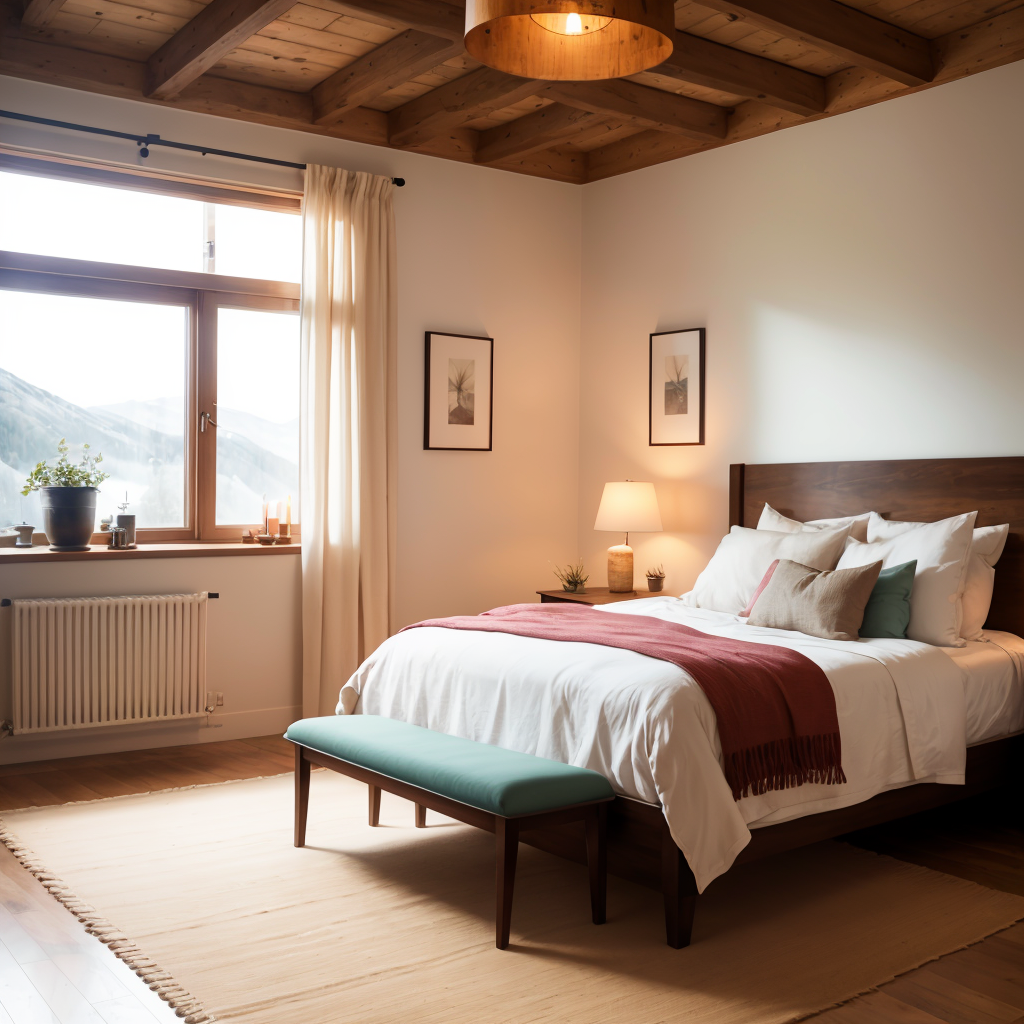
Go for bed linens in crisp white or pale colours like soft pink, blue or green; Dress your bed up with cozy textured throws and pillows made of wool-velvet mixes; add bedside tables made from natural woods alongside task lighting provided by adjustable desk lamps.
Bathroom:
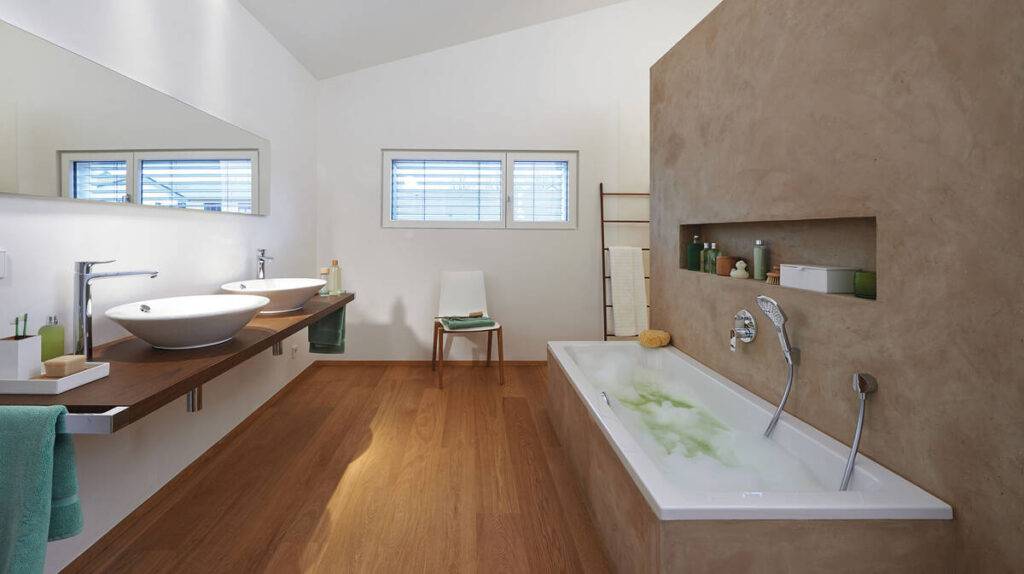
Scandinavian bathrooms are often designed using patterned tiles within shower areas whilst maintaining an overall minimalist approach throughout remaining aspects of this space- Natural stones complemented by porcelain sinks work well here along other touches like wall-mounted storage cabinets offering plenty of functionality.
Home office:
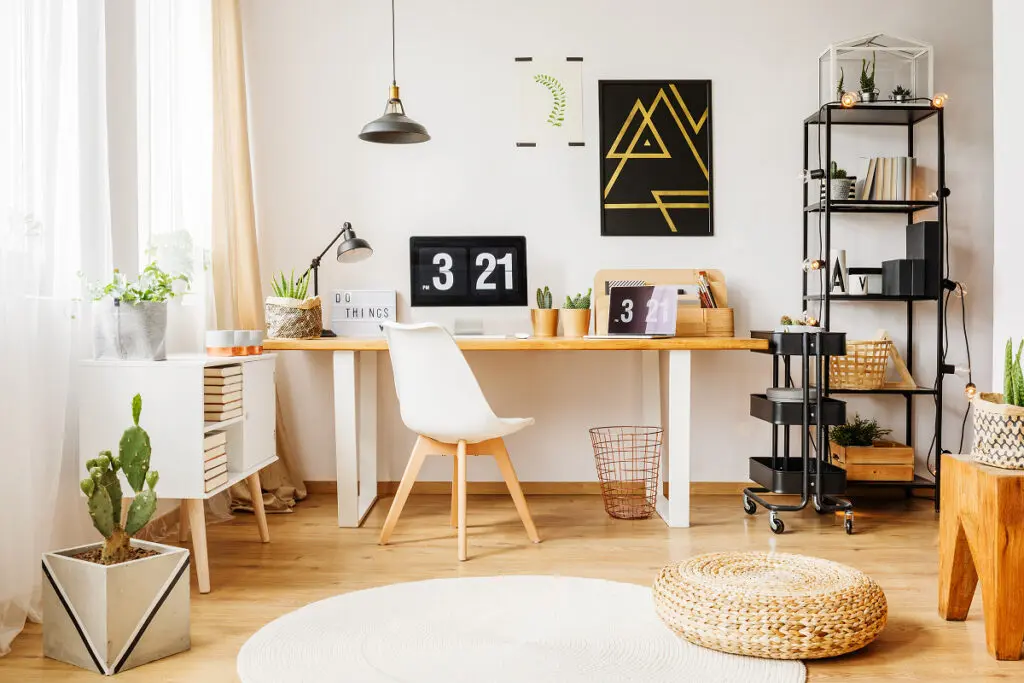
when setting up a workspace within your home it’s worth considering having ample table/desk space alongside shelves for storing books/documents combined comfortable seating options ensuring optimal comfort & efficiency during long working hours.
Remember that when it comes to Scandinavian interior design, less is more! Focus on clean lines, neutral color schemes paired alongside cozy textures & practical elements which create balance throughout different spaces bringing warmth into your home without detracting from its overall streamlined simplicity inviting you inside after long days at work





